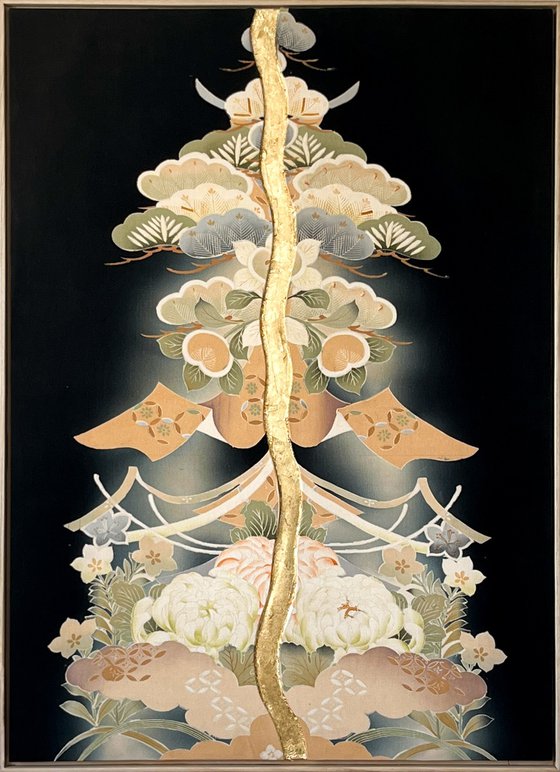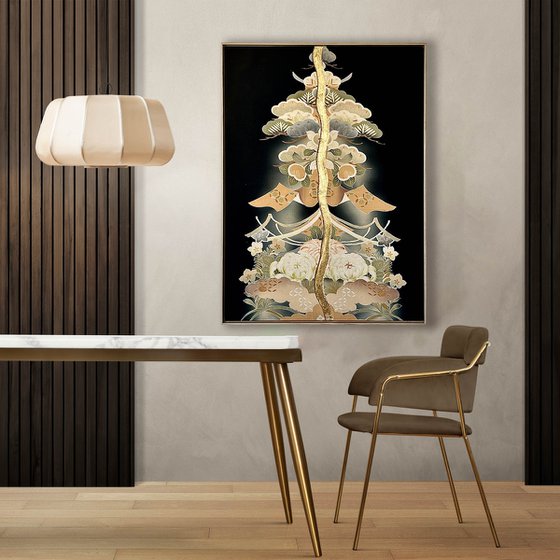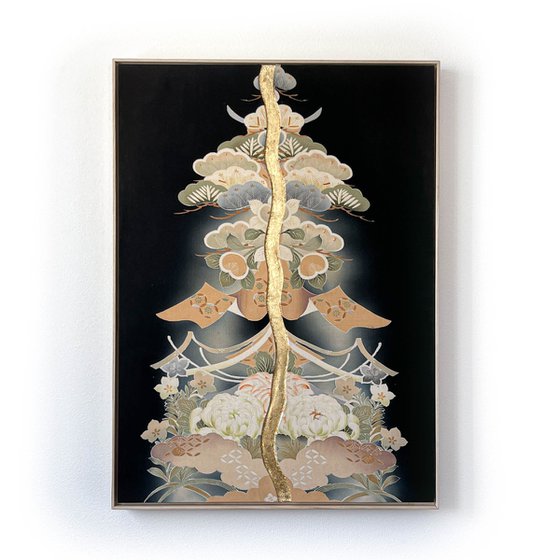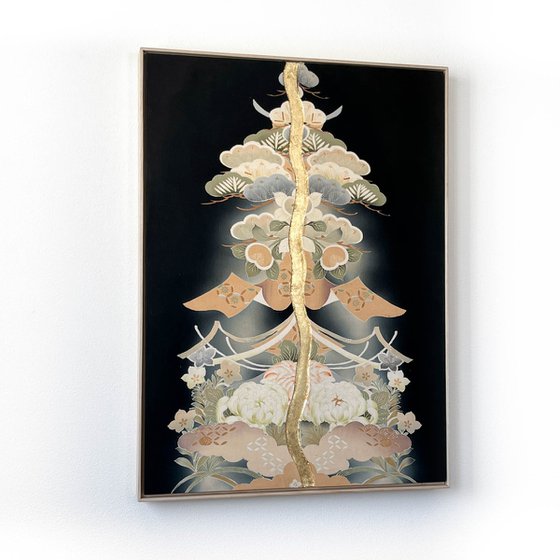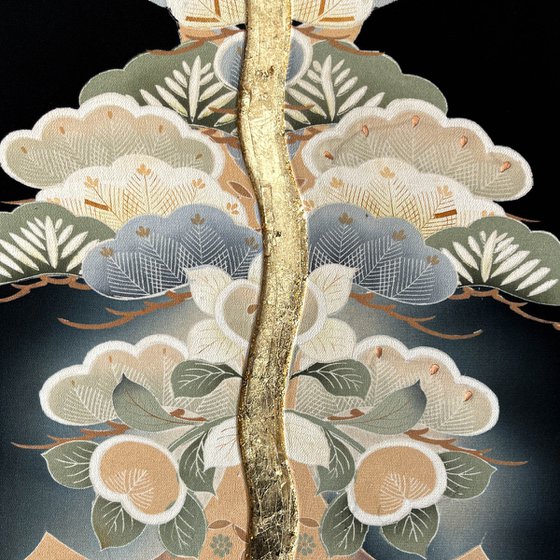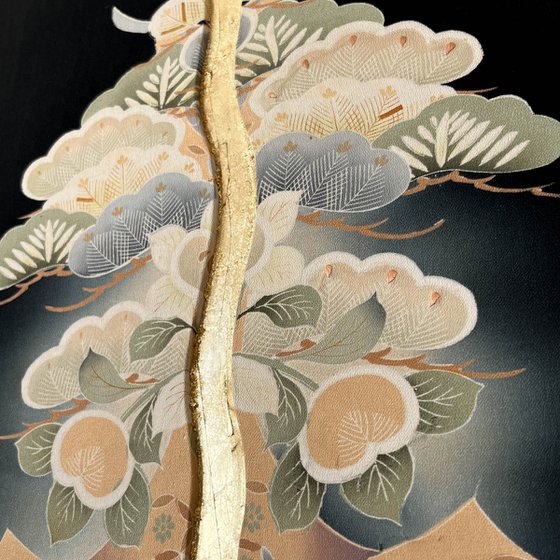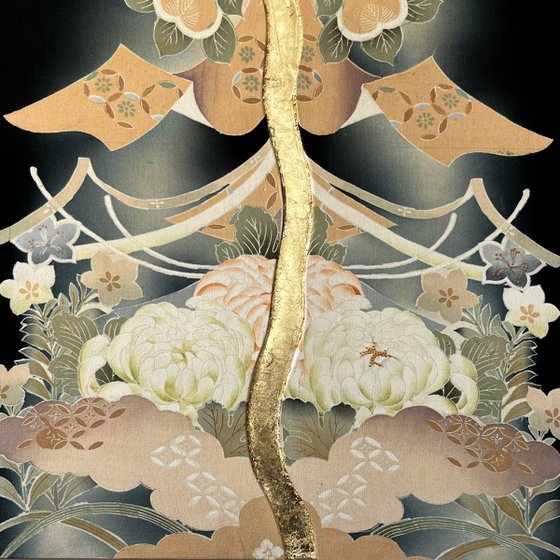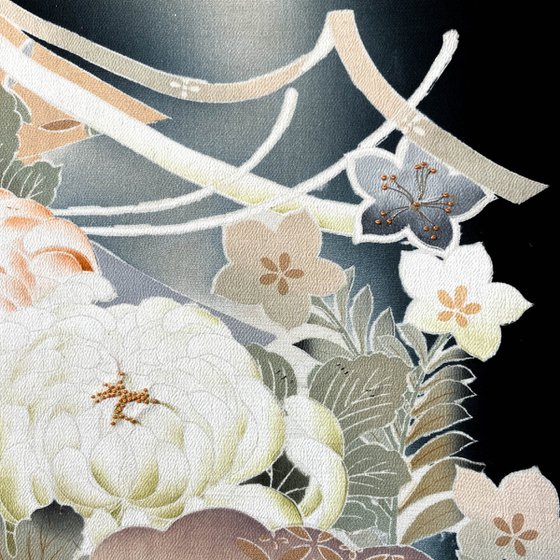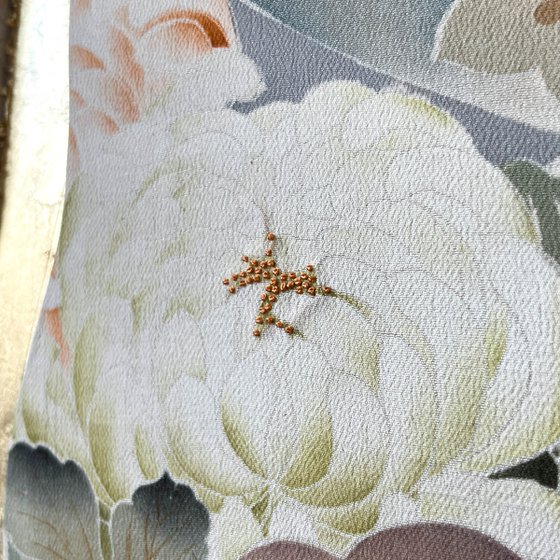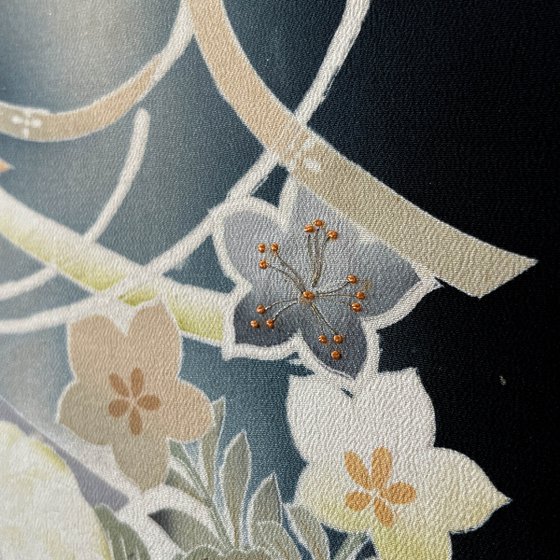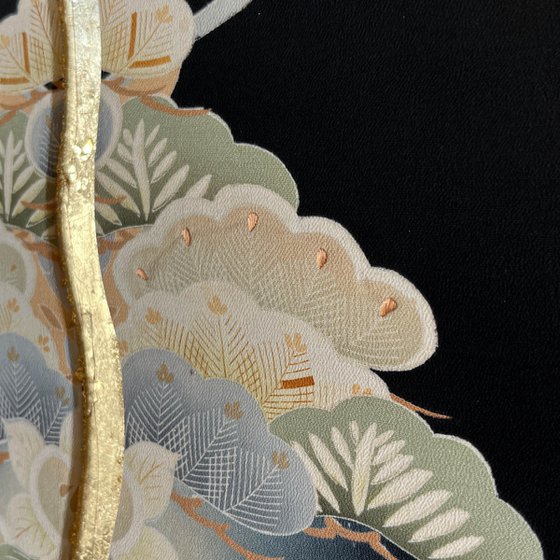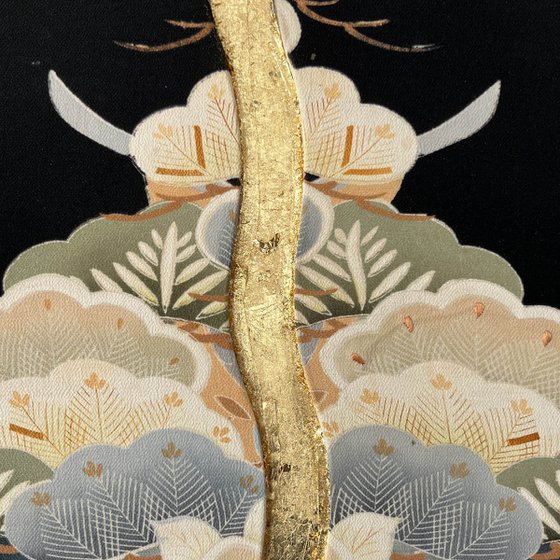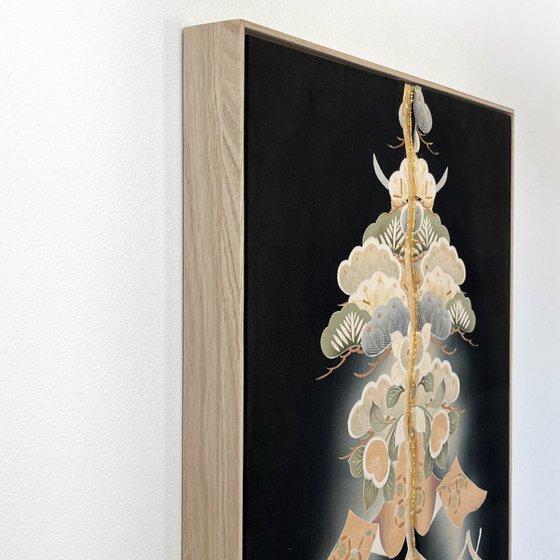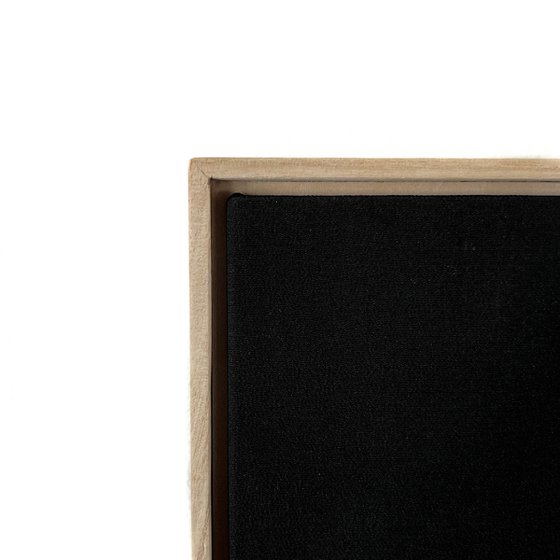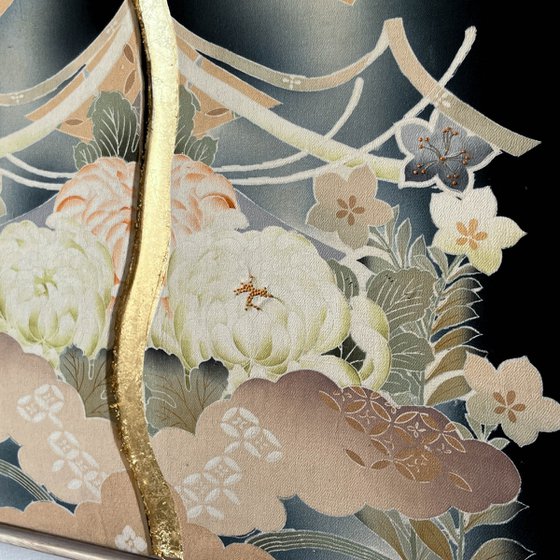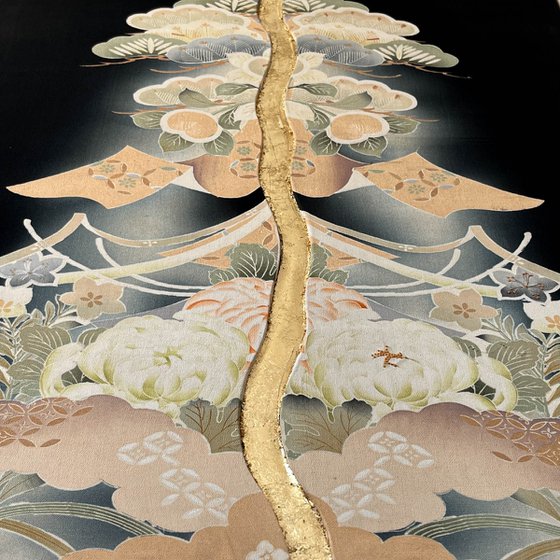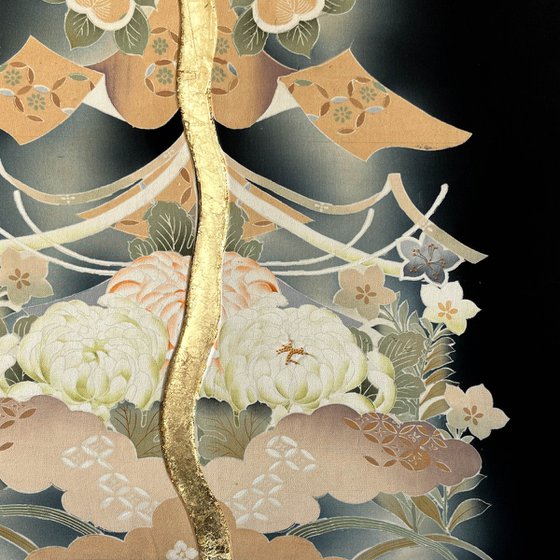Main Navigation
Original artwork description:
[Story behind the work]
This work uses an antique kimono fabric dated Taisho era (early 1910ies), with a pine tree motif, and arranges it so that it looks like a tree decorated with various auspicious symbols - persimmons, pines, peonies, etc.
The line in the middle symbolizes “kintsugi” - concept of wabi-sabi, which values imperfection, impermanence, and the beauty of aging.
It is elegantly framed with paulownia wood originally used for kimono chest-of-drawers, and is filled with storytelling and sense of luxury.
I used pieces of kimono that could no longer be used as clothing and kiritansu chest-of-drawers that would normally be discarded to create the ultimate upcycled piece.
[Period / Story]
The artwork uses kimono textile from Taisho era, around 1910-1920ies.
[Explanation and meaning of pattern and colors]
The art work features the matsu - pine pattern, which depicts the Japanese pine tree spreading over deep black fabric. It appears as if the pine dranches are decorated with various auspicious symbols - persimmons, pines, peonies, etc.
In East Asia, the pine tree is revered as a symbol of longevity due to its vibrant green leaves, even during the winter season.
In Japan, it's often referred to as the "evergreen tree" because its leaves remain green throughout the year, making it a symbol of good fortune that has been cherished for a long time.
[Characteristics of the fabric]
The fabric is hand-painted in traditional Japanese technique "yuzen".
[About the frame]
Kiritansu - chest-of-drawers for kimono, is traditionally made from paulownia wood, a uniquely Japanese material closely tied to the world of kimonos.
Paulownia wood is known as the lightest wood in Japan, prased for its natural luster, resistance to moisture, and resilience against cracking. Since ancient times, it has been used in crafting furniture, chests, and musical instruments.
During the Edo period, it became customary to store cherished kimonos in paulownia chests, which offered fire resistance and protection from moisture and insects.
Traditionally, when a daughter was born, a paulownia tree would be planted. Upon her marriage, the tree would be cut down, and the wood would be used to craft a chest for her as a wedding gift.
Following the Ansei Earthquake during the late Edo period in 1855, paulownia chests gained popularity due to their ability to withstand fires and even float in water, thereby safeguarding their contents during floods.
I use antique kiritansu that can’t be used as furniture anymore to create basis and frames for my works. It adds them even more authentic atmosphere of traditional wabisabi spirit. Can you feel it?
[Precaution]
All the works are made from real kimonos, antiques and vintages. For this reason, the fabric may have traces of long-term use and minor fabric damages. In case there are any scratches or stains, we always add a photo of the area on the item page, so please check before purchasing. Regarding precaution, cancellation and refund policy, please refer to the refund policy in the footer section of the site for information.
Materials used:
silk (outside-layer) , paulownia (wooden frame), gold leaf
Tags:
#japan #antique #gold relief #sustainabale art #kimono artFeatured by our Editors:
Prosperity Tree (Kimono Upcycled) (2024) Collage
by Lena Okamoto
£1,627.97 Sold
- Collage on Other
- One of a kind artwork
- Size: 53 x 73 x 5cm (framed)
- Framed and ready to hang
- Signed certificate of authenticity
- Style: Collage
- Subject: Flowers and plants
Do you like this artwork?
This artwork has sold, but the artist is accepting commission requests. Commissioning an artwork is easy and you get a perfectly personalised piece.
Loading
Original artwork description
[Story behind the work]
This work uses an antique kimono fabric dated Taisho era (early 1910ies), with a pine tree motif, and arranges it so that it looks like a tree decorated with various auspicious symbols - persimmons, pines, peonies, etc.
The line in the middle symbolizes “kintsugi” - concept of wabi-sabi, which values imperfection, impermanence, and the beauty of aging.
It is elegantly framed with paulownia wood originally used for kimono chest-of-drawers, and is filled with storytelling and sense of luxury.
I used pieces of kimono that could no longer be used as clothing and kiritansu chest-of-drawers that would normally be discarded to create the ultimate upcycled piece.
[Period / Story]
The artwork uses kimono textile from Taisho era, around 1910-1920ies.
[Explanation and meaning of pattern and colors]
The art work features the matsu - pine pattern, which depicts the Japanese pine tree spreading over deep black fabric. It appears as if the pine dranches are decorated with various auspicious symbols - persimmons, pines, peonies, etc.
In East Asia, the pine tree is revered as a symbol of longevity due to its vibrant green leaves, even during the winter season.
In Japan, it's often referred to as the "evergreen tree" because its leaves remain green throughout the year, making it a symbol of good fortune that has been cherished for a long time.
[Characteristics of the fabric]
The fabric is hand-painted in traditional Japanese technique "yuzen".
[About the frame]
Kiritansu - chest-of-drawers for kimono, is traditionally made from paulownia wood, a uniquely Japanese material closely tied to the world of kimonos.
Paulownia wood is known as the lightest wood in Japan, prased for its natural luster, resistance to moisture, and resilience against cracking. Since ancient times, it has been used in crafting furniture, chests, and musical instruments.
During the Edo period, it became customary to store cherished kimonos in paulownia chests, which offered fire resistance and protection from moisture and insects.
Traditionally, when a daughter was born, a paulownia tree would be planted. Upon her marriage, the tree would be cut down, and the wood would be used to craft a chest for her as a wedding gift.
Following the Ansei Earthquake during the late Edo period in 1855, paulownia chests gained popularity due to their ability to withstand fires and even float in water, thereby safeguarding their contents during floods.
I use antique kiritansu that can’t be used as furniture anymore to create basis and frames for my works. It adds them even more authentic atmosphere of traditional wabisabi spirit. Can you feel it?
[Precaution]
All the works are made from real kimonos, antiques and vintages. For this reason, the fabric may have traces of long-term use and minor fabric damages. In case there are any scratches or stains, we always add a photo of the area on the item page, so please check before purchasing. Regarding precaution, cancellation and refund policy, please refer to the refund policy in the footer section of the site for information.
Materials used:
silk (outside-layer) , paulownia (wooden frame), gold leaf
Tags:
#japan #antique #gold relief #sustainabale art #kimono artFeatured by our Editors:
14 day money back guaranteeLearn more
